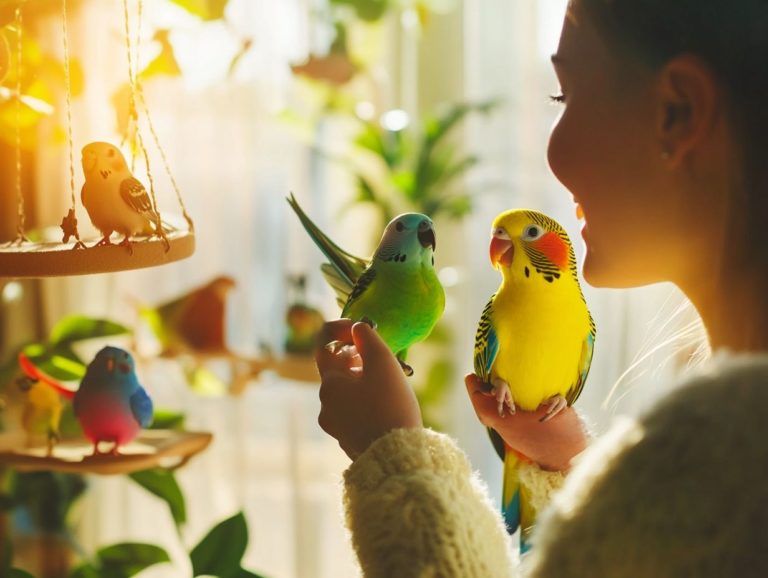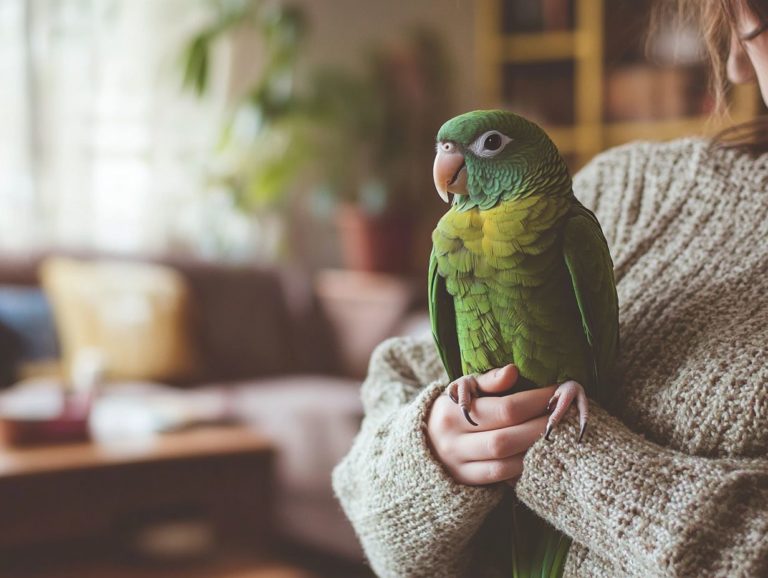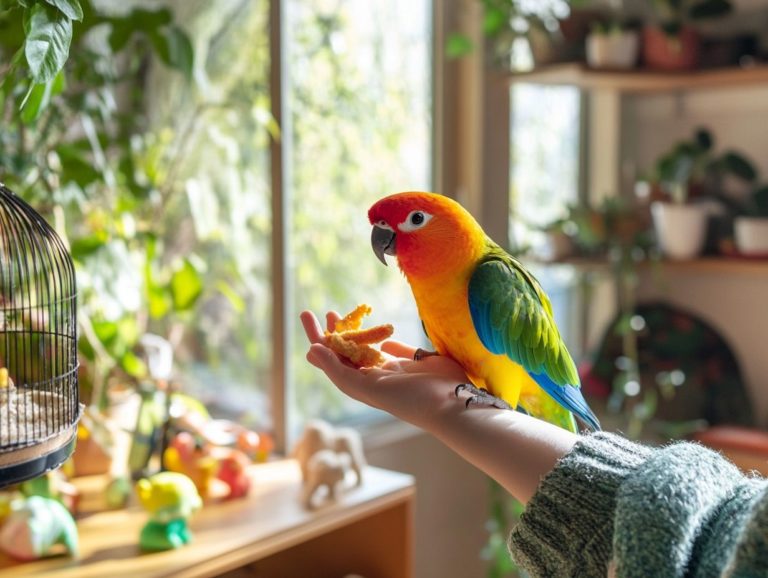Using Treats for Effective Bird Training
Training birds is a rewarding experience, and utilizing treats is one of the most effective ways to encourage positive behavior.
This guide explores the advantages of positive reinforcement, discusses the best types of treats to use, and provides insights on how to implement them effectively.
You’ll also find valuable information on common pitfalls to avoid and practical solutions for challenges that may arise during your training process.
Whether you’re a seasoned bird owner or just starting your journey, this guide will transform your training experience!
Contents
- Key Takeaways:
- Why Use Treats for Bird Training?
- Types of Treats for Birds
- When and How to Use Treats
- Common Mistakes to Avoid
- Troubleshooting Treat Training
- Frequently Asked Questions
- What are the benefits of using treats for effective bird training?
- What types of treats are best for bird training?
- How frequently should I use treats in bird training?
- What is the best way to incorporate treats into bird training?
- How can I prevent my bird from only responding to treats?
- Are there any birds that may not respond well to treat-based training?
Key Takeaways:
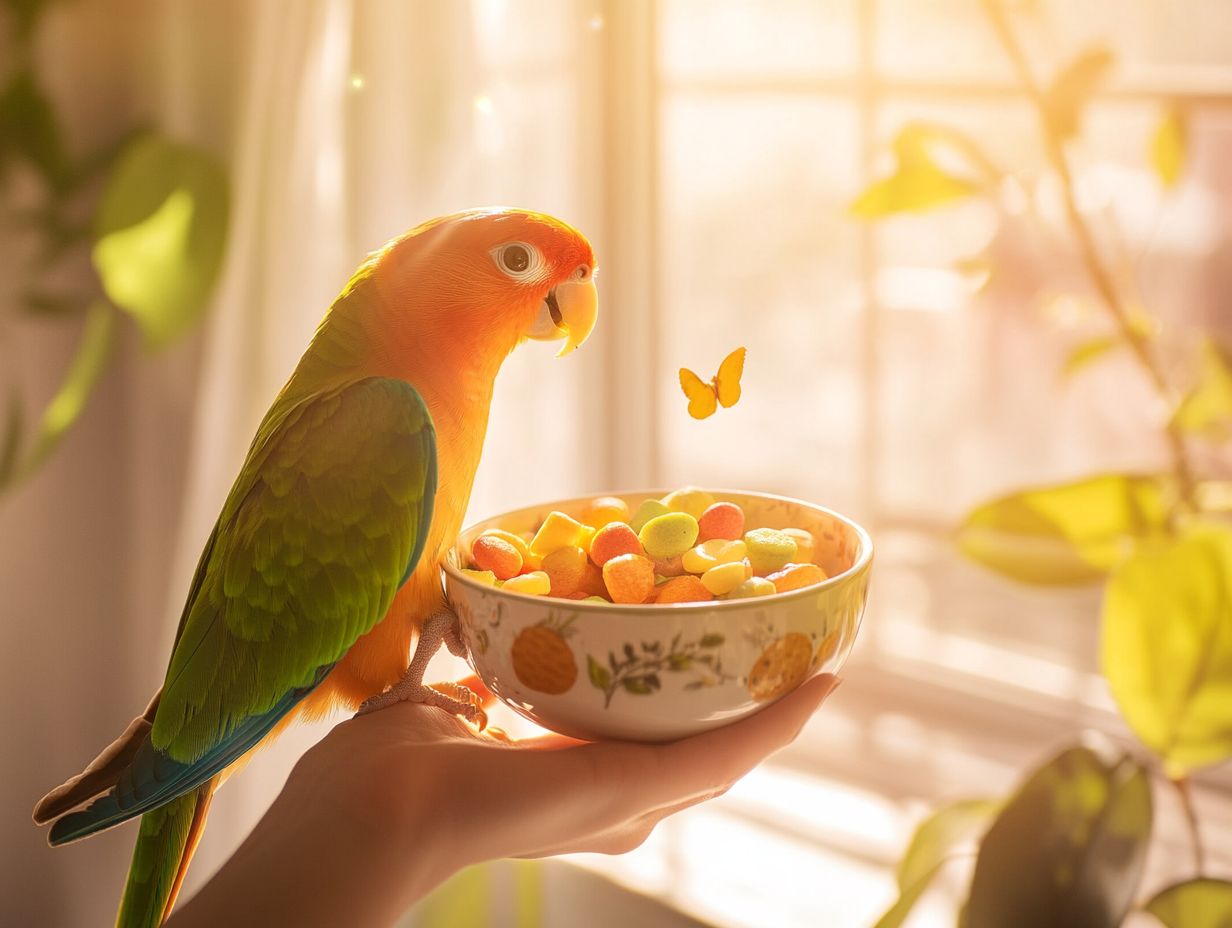
- Positive reinforcement with treats is an effective and ethical method for bird training, promoting trust and bonding between owner and bird.
- Healthy and appropriate treats, such as fruits and vegetables, should be used in moderation to maintain a balanced diet and prevent overfeeding.
- Timing and technique are crucial for successful treat training. Avoid common mistakes, such as overfeeding and negative associations, to ensure maximum effectiveness.
Why Use Treats for Bird Training?
Using treats for bird training is an incredibly effective way to elevate the learning experience for your pet birds. This method, grounded in positive reinforcement, encourages the behaviors you want to see.
By introducing nutritious bird treats, such as ZuPreem Real Rewards and Kaytee, along with fresh vegetables, you can create enjoyable bonding experiences.
These treats cater to the unique food preferences and dietary needs of your avian companions. This approach not only builds trust but also plays a vital role in training behaviors, making each of your training sessions both productive and enriching for you and your feathered friend.
Benefits of Positive Reinforcement
Positive reinforcement stands as a remarkable training method that employs rewards think healthy training treats to encourage desirable behaviors in your pet birds. This significantly enhances their health and overall well-being.
This approach motivates your birds to learn commands or tricks while nurturing a deeper bond between you and your feathered companions.
For example, when you offer small pieces of millet or nutritionally balanced pellets each time your bird successfully performs a desired action, you create a positive learning environment that resonates with them.
What makes this method particularly effective is its appeal to the birds instinctual behaviors, transforming learning into an engaging and rewarding experience.
With consistent use of training treats, you ll reinforce good behaviors and provide essential mental stimulation, paving the way for a happier and healthier life for your avian friend.
Types of Treats for Birds
When selecting the finest treats for birds, it s crucial to prioritize options that promote healthy nutrition. Consider offering a delightful variety, including:
- Sunflower seeds
- An assortment of nut varieties
- Specially formulated bird treats designed to meet the unique dietary needs of various species
This thoughtful approach ensures your feathered companions enjoy both flavor and health in their treats.
Healthy and Appropriate Options
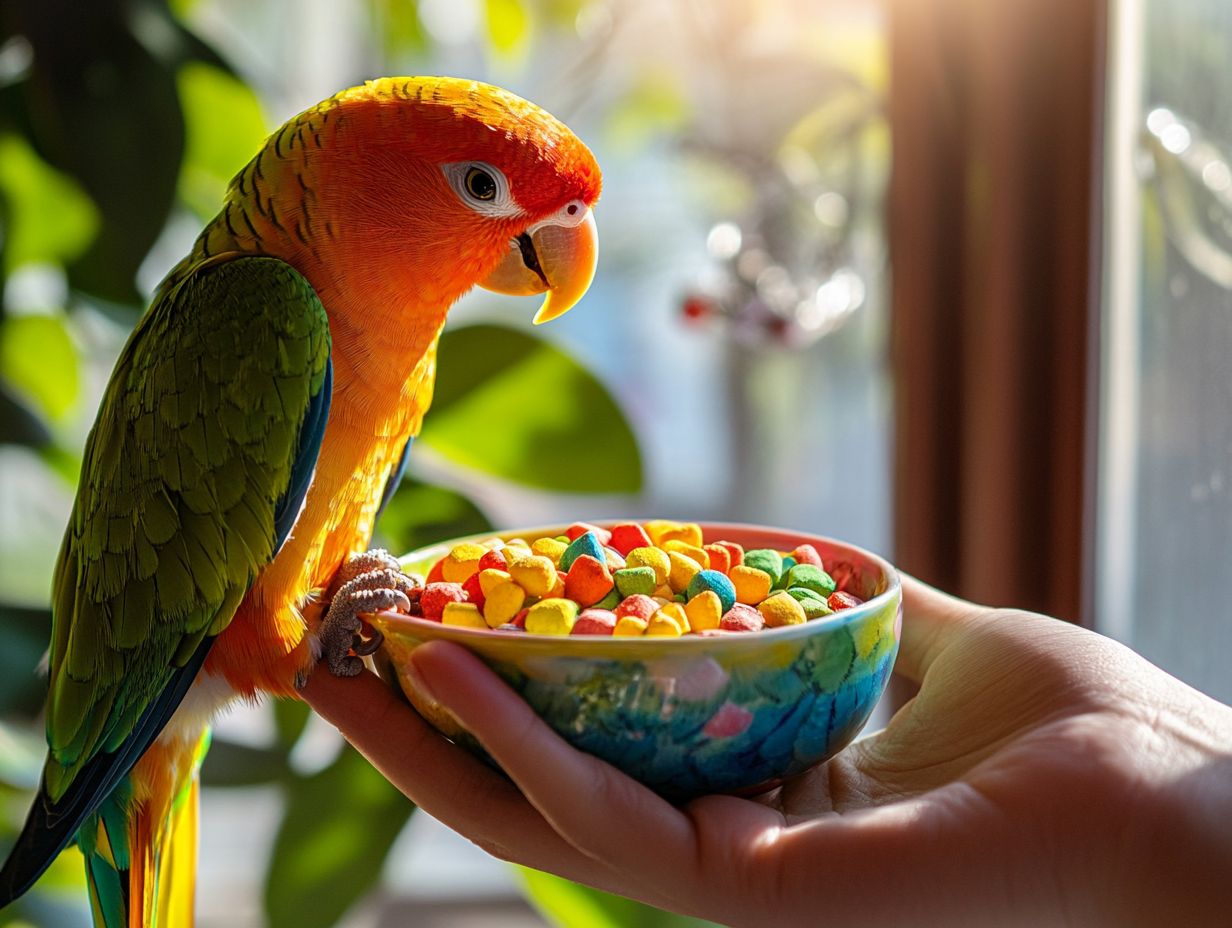
Healthy and appropriate treat options, like ZuPreem Real Rewards and fresh vegetables, are essential for maintaining the well-being of your pet birds while also serving as effective training tools.
These treats deliver vital vitamins and minerals and encourage positive behavior, enhancing the bond you share with your feathered friend.
Take, for instance, the delightful variety of flavors offered by ZuPreem. They provide a convenient way to reward your birds, being low in sugars and packed with natural goodness both delicious and nourishing.
Fresh vegetables, such as carrots and leafy greens, are bursting with antioxidants and promote overall health, making them excellent alternatives to processed snacks.
When selecting treats, it’s crucial to consider the specific dietary needs of different bird species, ensuring they receive maximum nutritional benefits while enjoying an occasional indulgence.
Start training your birds today using the methods discussed for a rewarding experience!
When and How to Use Treats
To truly maximize the benefits of treats during training sessions, you must grasp the nuances of timing and techniques for treat testing. This way, each reward boosts your bird s learning and elevates the overall effectiveness of your training experience.
Timing and Techniques for Maximum Effectiveness
Mastering the timing and techniques of treat delivery is essential for achieving optimal results and creating a positive learning environment for your pet bird.
Knowing precisely when to reward can transform the experience. For example, offering a treat immediately after your feathered companion performs a desired behavior reinforces their learning and provides clear feedback.
Rewarding at different times at unpredictable intervals can keep them engaged and motivated. How you present treats also plays a crucial role; incorporating hand signals or verbal cues alongside the treat helps build strong associations and enhances communication.
Don’t hesitate to experiment with various types of treats, from their absolute favorites to delightful surprises. This not only enriches the training experience but also makes it enjoyable for both you and your bird.
Common Mistakes to Avoid
When choosing treats for bird training, it’s essential to steer clear of common pitfalls like overfeeding and selecting unhealthy options, as these can create negative associations for your feathered friends and adversely affect their overall health.
Prioritizing the right treats enhances their training experience and promotes their well-being.
How to Prevent Overfeeding and Negative Associations
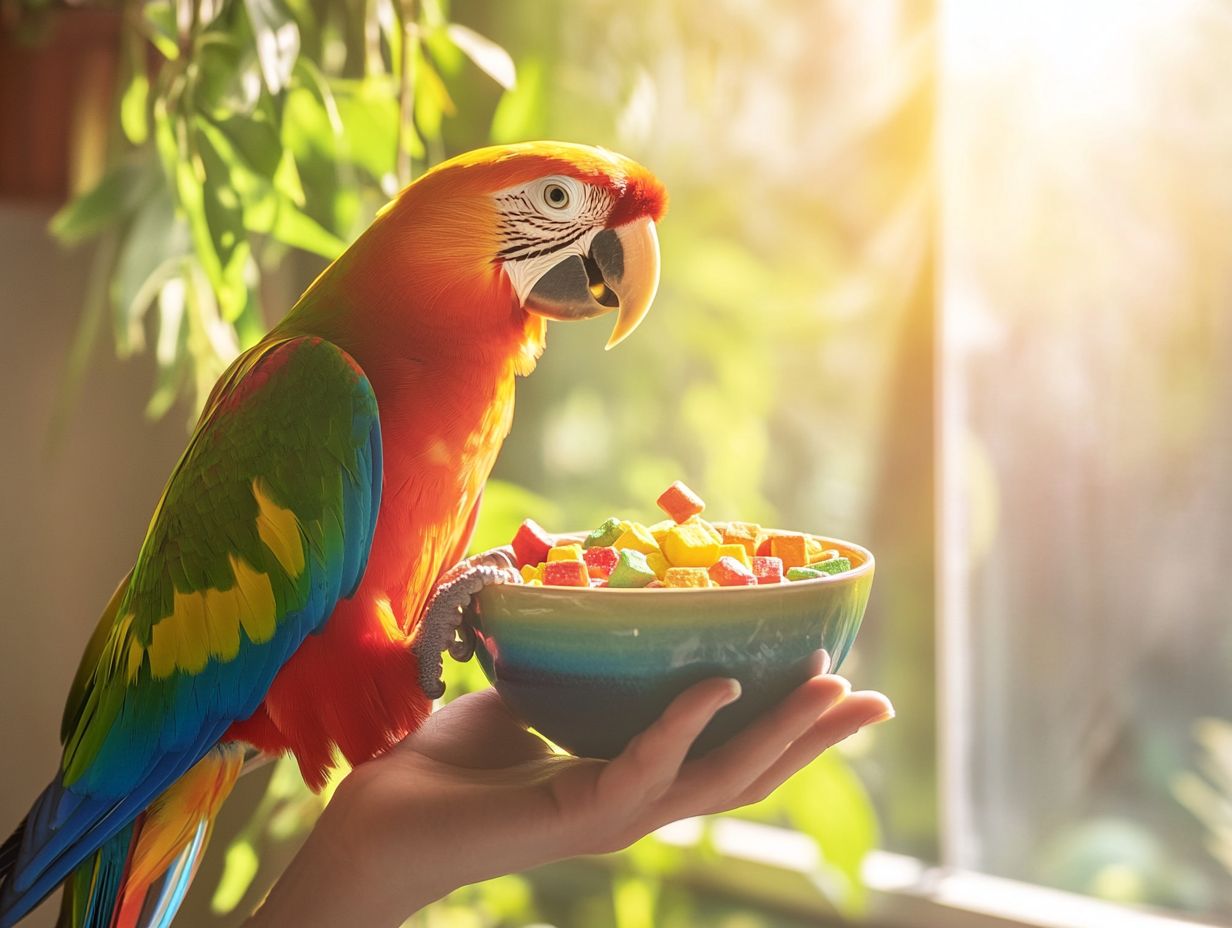
To prevent overfeeding and create positive associations with training treats, monitor your pet bird s diet composition and adopt a balanced approach to reward training.
Determine the appropriate portion sizes based on your bird s species and weight. Incorporating a mix of high-nutrient pellets, fresh fruits, and vegetables greatly contributes to a well-rounded diet. Opting for small, low-calorie treats as rewards allows you to reinforce desirable behaviors without worrying about excess calories.
Vary the types of rewards you use to keep your bird engaged and interested throughout the training process. By keeping an eye on your pet’s overall behavior and health, you ll gain vital insights into how well the current feeding regimen is working, enabling you to make necessary adjustments.
Troubleshooting Treat Training
Troubleshooting treat training requires you to identify challenges and adapt your strategies, ensuring a successful and rewarding experience for both you and your bird.
This thoughtful approach not only addresses any difficulties but also enriches the bonding experience between you and your feathered companion.
Addressing Challenges and Adjusting Strategies
Addressing challenges in treat training requires adjusting your strategies based on your bird’s unique responses during each session, ensuring that every experience remains both positive and effective for your macaws.
To effectively recognize these challenges, pay close attention to your bird’s body language and any signs of hesitation during training. If they appear disinterested or anxious, it might be time to reconsider the types of treats you’re using, ensuring they are enticing enough to capture their attention.
Varying the training environment minimizes distractions that might inhibit focus. Shortening your training sessions can be beneficial, allowing you to maintain high levels of engagement without the risk of fatigue. Incorporating play or a favorite toy as a reward can further enhance motivation, transforming the training experience into something enjoyable and significantly more productive.
Frequently Asked Questions
Start applying these tips today to see amazing progress with your bird’s training!
What are the benefits of using treats for effective bird training?

Treats are a fantastic way to motivate and reward your bird during training. They help reinforce positive behaviors and make learning fun!
What types of treats are best for bird training?
Fresh fruits, vegetables, nuts, and small pieces of low-fat meat are great options. Avoid sugary or fatty treats to keep your bird healthy!
How frequently should I use treats in bird training?
Use treats sparingly during training to prevent overfeeding. Just a few small treats throughout the session can effectively reinforce good behavior.
What is the best way to incorporate treats into bird training?
Use treats as rewards for specific behaviors you’re teaching. This helps your bird understand expectations and encourages them to keep up the good work!
How can I prevent my bird from only responding to treats?
Gradually reduce treat usage as your bird becomes more skilled in training. Eventually, they should respond to praise and affection instead of treats.
Are there any birds that may not respond well to treat-based training?
Some birds, especially those with special diets, might not be suitable for treat training. Always consult your avian vet before adding treats to your bird’s training routine.


